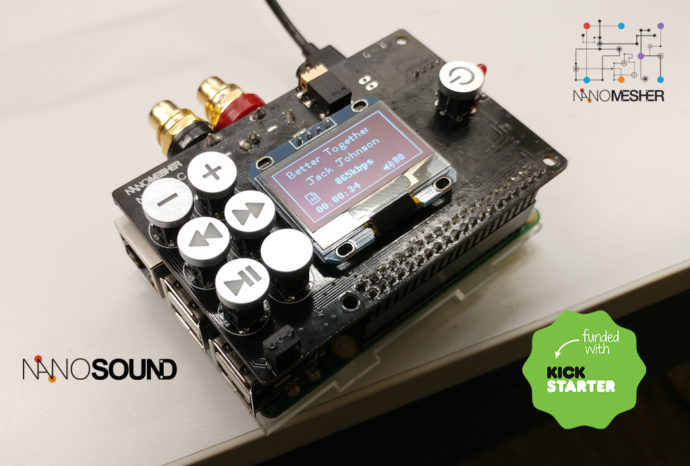NanoSound – All-in-one Hifi Audio Board for Raspberry Pi
All-in-one Audio Add-on Board for Raspberry Pi with DAC, OLED Display, Power Switch, Control Buttons and Infrared Remote Control.
This project has already been 100% funded after 30 hours of launching. The campaign is still going on for another 38 days, please support us if you are interested in it.
Please visit the Kickstarter site to back for this project
About this project

NanoSound is a Raspberry Pi audio add-on board for audiophiles. While it works out of the box running volumio & kodi, it is designed to be fully customizable and configurable by taking advantage of Raspberry Pi.
Note that the buttons of the infrared remote control with be fully labeled in the production version

Yes, it works out of the box with Volumio & Kodi. A pre-configured Volumio & Kodi image will be available for download. Just plug NanoSound onto the Raspberry Pi, assemble the included mounting screws, insert the SD card and it’s done!


NanoSound is an audio add-on board designed to plug on top of Raspberry Pi 2 / 3 (which has 40-pin GPIO connector).
It combines:
- Texas Instruments PCM5122 DAC (24bit Resolution & 384khz Sampling Rate)
- Power switch (using same design as our Pi Switch product)
- 6 GPIO buttons for Media Control
- Infrared receiver and remote control
- 1.3″ OLED display with multi-language support


It provides an all-in-one solution for audiophonics who want an affordable and high quality DAC with many convenience features.

Absolutely, NanoSound is fully customizable and programmable! we take full advantage of the Raspberry Pi’s open architecture.
- The 6 buttons are simple GPIO buttons. Python source code will be provided to read button events.
- The IR receiver and control is LIRC compatible. Lircd.conf will be provided to read button input.
- The 1.3″ OLED display is using i2c. The python display driver code is open sourced.
- The onboard on/off switch uses the same design and software as our first kickstarter project. It has an attiny85 onboard and is open sourced.

Because NanoSound’s DAC uses the very common Texas Instruments PCM5122 DAC chip, it is compatible with many distributions (such as Openlibre, Raspbian) etc. Nanosound’s DAC uses the same driver as HifiBerry DAC+ .

NanoSound uses a high quality Texas Instruments PCM5122 DAC (Burr Brown 112/106-dB Audio Stereo DAC With 32-bit, 384-kHz). It is also accompanied by Hifi grade capacitors from EVOX RIFA, WIMA and ELNA.
We have tested NanoSound with many hi-end hifi systems and headphone. The quality is really good and on par with audio player which cost a few hundred USD more.
We have done blind listening comparison with other DACs using same chipset. As far as we are hear, they all sound equally good!

Yes, 3D printed case will be available for optional add-on item and is undergoing development. The stl file will be downloadable for free for those who want to print their own case.


Rewards & Models:

NanoSound Basic (You can add the 1.3″ OLED Display Later)

NanoSound Pro

Installation
Not a techie? Dont worry, installation is very simple:





